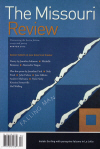The Missouri Review – Winter 2013
In his lucid, wise introduction to this issue of the highly-reputed Missouri Review, Editor Speer Morgan invokes paradox and opposition, those twin universals of human existence, as the theme of the day. “Falling man” is the image on the cover and the title of his survey of the issue’s contents, and in referring to “the potential uncertainty of the given” as the driving principle of its stories, essays, and poems, he’s utterly correct. But I’d also argue that another theme, present in equal abundance, is beauty of language, deep respect for the right words in the right order, every bit as much in the prose as in the poetry. This—as always—is a magazine for the connoisseur. There is nothing amateur about it.
In his lucid, wise introduction to this issue of the highly-reputed Missouri Review, Editor Speer Morgan invokes paradox and opposition, those twin universals of human existence, as the theme of the day. “Falling man” is the image on the cover and the title of his survey of the issue’s contents, and in referring to “the potential uncertainty of the given” as the driving principle of its stories, essays, and poems, he’s utterly correct. But I’d also argue that another theme, present in equal abundance, is beauty of language, deep respect for the right words in the right order, every bit as much in the prose as in the poetry. This—as always—is a magazine for the connoisseur. There is nothing amateur about it.
Take, for example, “The Edge Effect: Surfing with Peregrine Falcons in La Jolla,” Nick Neely’s soaring profile of lay ethologist Will Sooter, written in language that parallels the swooping, stooping falcons he observes and photographs. Several of Sooter’s stunning shots illustrate the pages, but you can’t help falling in love with Neely’s phrases, too:
Strands of kelp looked like the raw vertebrae of whales. Here would come a wave, exposing tiny bean clams, no larger than a toenail and smoother. Purple, pastel orange. Instantly the little angel wings would scoot upright, replanting their edges in the sand.
Here’s another sampling:
Also “mock combat”: . . . It’s a prolonged chase, punctuated by moments of tumbling. First they “mirror” each other, flying side by side, as if tied by their wings. Then tag: rock toward your brother, talons extended, cacking. Fly on your back for an instant, talons grappling . . . We were like kids at an airshow.
The sentences reflect the energy of the peregrines’ flight and the gleeful enthusiasm of their watchers. The end of the essay, a scene in which Neely himself flies among the birds, lands us gently, not altogether ready to stop our glide, back on solid ground. If man falls here, it’s on purpose, to mimic the birds of the wild.
Another gripping essay, Jonathan Fink’s “The Dreamers,” chronicles two sides of the oil boom in Midland, Texas—the conspicuous influx of jobs, the equally glaring impermanence and ugliness that go with it. His investigation came out of an assignment given to his students to choose a clearly problematic question associated with a distinctive place; they must interview individuals whose points of view reflect multiple sides of the question, and they must question their own assumptions. Fink interviewed workers brought to Midland by the boom and citizens who have watched its effects; the interviews demonstrate not only the requisite open mind, but also a perceptive ear. There is no easy conclusion. Booms have busts. Midland is somewhere in the middle of that arc, and the simmering tension is unmistakable.
Jane Gillette’s short story “Meditation XXXI: On Sustenance” resonates like another piece of creative nonfiction, with a snarky narrator whose commentary on food snobbery waxes as diametric as Fink’s about oil booms. But this is beautifully-structured fiction, and the “one scene” toward which the entire story funnels brings together so elegantly the irony of the narrator’s squinty perceptions that we’re hooked long before we ever get to it. The protagonists’ gourmet restaurant Locavore is juxtaposed deliciously against the town’s other diner, Bessie Sue’s. Locavore is meticulously run by a foodie willing to buy “expensive, politically complicated” licenses and to persuade local farm families to produce year-round for her. But many times more paragraphs are devoted to Bessie Sue’s, who menu includes:
thick, aromatic onion soup (concocted of canned bouillon, fried onion slices and Velveeta), a wedge of iceberg lettuce served with bottled blue cheese or Thousand Island dressing, main courses of chicken smothered in raspberry jam, a big filet, a small filet, fish of various kinds (flown in more or less daily), spinach ravioli (mass-produced by a company outside Denver) . . .
When the fate of Locavore’s owners is revealed, the truth that “God eats the world in little bites” is both the excruciating conclusion from which there is no escape, and the epiphany that redeems them.
Jennifer Atkinson’s poems show landscapes wild and decaying. Kristine Somerville’s photo-illustrated essay on the life and work of the dancer Ruth St. Denis narrates her early life full of external obstacles and her later life full of internal ones. John Fulton’s wonderful short story “What Kent Boyd Had” mimics The Things They Carried in an Updikean, middle-American- tragic way, and Sarah T. Schwab’s interview with playwright and director Dennis Talbott laments the lack of funding for theater, yet encourages artists to use the situation to their advantage. Poetry by Michelle Boisseau and Alexandra Teague give marvelous form to the oppositions of (respectively) micro/macro and weapon-skill; and the review by Andrew Mulvania of new biographies of Sylvia Plath resounds with the perversities of her life story. Throughout, ambiguity reigns in the most excellently-written way. This is an issue to covet. Nobody gets home free.
[www.missourireview.com]





